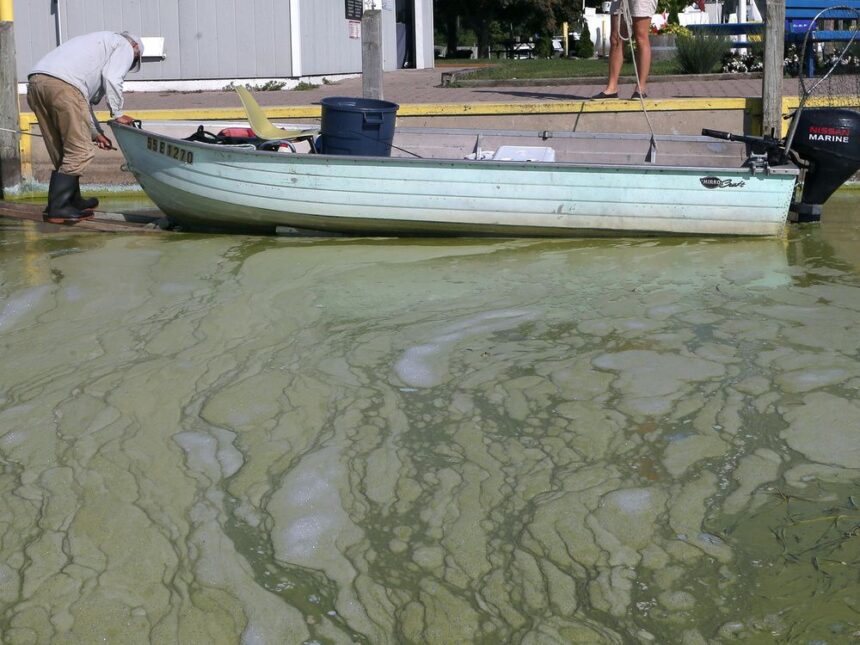The late summer heat hangs heavy over Belle River as Luc Marchand pulls his small fishing boat to shore. The 62-year-old lifelong resident points to the greenish scum gathering along the banks of the Ruscom River, his face etched with concern.
“I’ve been fishing these waters since I was a boy,” Marchand tells me, squinting against the afternoon sun. “Never seen it this bad before. The water doesn’t even look like water anymore.”
What Marchand is describing is the unmistakable signature of blue-green algae blooms that have triggered a public health warning across the region. Yesterday, the Windsor-Essex County Health Unit issued an advisory urging residents to avoid contact with water in the Ruscom River following the detection of cyanobacteria—commonly known as blue-green algae.
The warning comes after water samples confirmed what many locals had already observed: a potentially dangerous algal bloom has taken hold in one of the region’s vital waterways. The Health Unit’s environmental health team has been monitoring the situation since receiving reports from concerned residents last week.
“We’re asking people to be extremely cautious,” explains Dr. Wajid Ahmed, Medical Officer of Health for Windsor-Essex County. “These blooms can produce toxins that pose serious health risks to humans, pets, and wildlife. Direct contact with the water, even accidental ingestion during swimming, could lead to illness.”
The health risks aren’t trivial. According to Health Canada, exposure to cyanobacterial toxins can cause skin irritation, gastrointestinal issues, and in severe cases, liver damage. For pets who drink contaminated water, the consequences can be fatal.
For many residents living along the Ruscom River, which flows into Lake St. Clair, the advisory represents more than just a temporary inconvenience—it’s becoming a recurring summer nightmare.
“Three summers in a row we’ve had to keep our grandkids away from the water,” says Maria Kovacevic, whose backyard extends to the river’s edge. “They don’t understand why they can’t swim. How do you explain toxic algae to a five-year-old?”
The science behind these increasingly common blooms points to a complex intersection of climate change and human activity. Warming water temperatures create ideal conditions for cyanobacteria growth, while agricultural runoff rich in phosphorus and nitrogen—primarily from fertilizers—provides the nutrients these organisms need to flourish.
Dr. Hugh MacIsaac, professor at the Great Lakes Institute for Environmental Research at the University of Windsor, has been studying algal blooms across the Great Lakes region for decades.
“What we’re seeing in the Ruscom River reflects a broader pattern across the entire Great Lakes watershed,” MacIsaac explains when I call him for context. “Climate change is extending the bloom season, while intense spring rains wash more nutrients into our waterways. It’s creating perfect conditions for these events to become more frequent and more severe.”
The Ontario Ministry of Environment, Conservation and Parks has been collaborating with local conservation authorities to implement nutrient management strategies, but progress has been slow. Data from the Essex Region Conservation Authority shows phosphorus levels in regional waterways consistently exceeding provincial water quality objectives.
For local businesses dependent on summer water recreation, these advisories deliver a significant economic blow. Just five kilometers downstream from where I meet Marchand, Ruscom River Marina sits unusually quiet for a late August afternoon.
“We’ve had to cancel two fishing charters already,” says marina owner Devon Williams. “When people hear ‘toxic algae,’ they stay away. Can’t blame them, but it hurts our bottom line.”
Williams estimates that algal bloom advisories cost his business nearly $20,000 in lost revenue last summer. “If this becomes the new normal, small operations like mine won’t survive.”
The health unit advises residents to look out for water that appears like green pea soup or turquoise paint. Other warning signs include dense surface scum or a strong musty odor. Anyone who suspects they’ve encountered blue-green algae should rinse off with clean water immediately and seek medical attention if they experience symptoms like headache, fever, dizziness, or stomach cramps after contact.
Local environmental groups are mobilizing in response to the latest bloom. The Essex County Clean Water Advocates, a grassroots organization focused on water quality issues, has scheduled community information sessions to help residents understand both the causes and potential solutions.
“This isn’t just an environmental issue—it’s a public health crisis and an economic threat to our communities,” says Jennifer Torres, the group’s coordinator. “We need stronger regulations on agricultural runoff and better monitoring systems that can detect these blooms earlier.”
As the sun begins to set over the Ruscom River, casting an amber glow across water that should be clear but instead resembles thick green paint, Marchand loads his unused fishing gear back into his truck.
“My grandfather taught me to fish here,” he says quietly. “I taught my kids, and I was hoping to teach my grandkids too. But now…” He gestures toward the contaminated water. “Now I don’t know if that tradition will continue.”
The health unit’s advisory remains in effect until further notice, with water testing scheduled to continue throughout the week. Residents seeking more information can contact the Windsor-Essex County Health Unit or visit their website for updates and safety guidelines.
As I drive away from the river, I pass a faded sign welcoming visitors to the “Beautiful Ruscom River Area.” The irony isn’t lost on anyone who has seen the current state of these waters—a visible reminder of how quickly environmental degradation can transform a community’s relationship with the natural world that has sustained it for generations.






